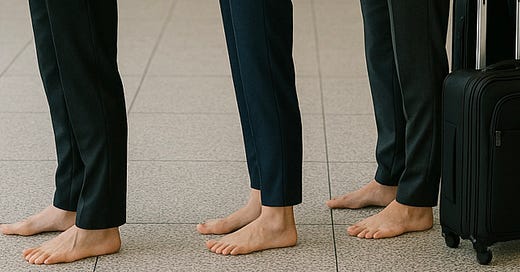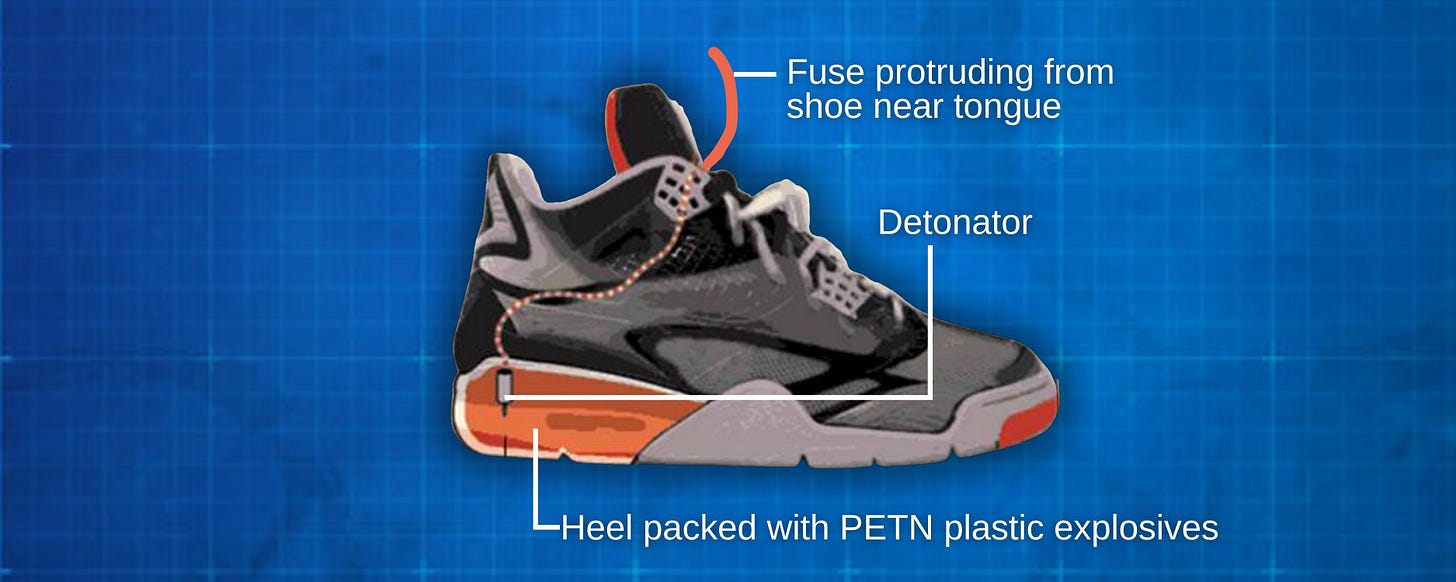The Transportation Security Administration, in an announcement greeted with collective national relief and a sense of long-overdue sanity, has finally ended its longstanding one-size-fits-all policy requiring travelers to remove their shoes at airport security checkpoints. Our long national nightmare is over. The end of this rule marks the close of a performance that, for more than twenty years, has been derided by critics as pure security theater. It was never a serious defense against terrorism, merely a burdensome ritual whose most lasting legacy may well be the spread of foot fungus.
Let us start at the beginning, with Richard Reid. On December 22, 2001, Reid, a British national radicalized by Islamist ideology, boarded American Airlines Flight 63 from Paris to Miami with explosives concealed in his shoes. The bomb never detonated. Reid was overpowered by passengers and crew. The flight landed safely. The threat, while real, was neutralized not by policy, but by vigilance and circumstance. The plot failed. But in a curious inversion, the TSA treated this failure as a success for the terrorist. Though the bomb did not go off, his method reshaped the entire security posture of American aviation.
At the time, the TSA was newly formed. Still in its infancy, the agency was under immense pressure to demonstrate resolve and authority. In that climate, visible action supplanted strategic deliberation. Passengers were soon encouraged, then compelled, to remove their shoes at screening checkpoints. But here is the obvious question: if shoe removal was such a vital defense, why did it take five years to become mandatory? Was the risk not greater in the immediate aftermath of the attempted bombing, when national vulnerability was at its peak? The delay reveals the unseriousness of the measure. By 2006, the practice had become policy. This rule endured for nearly twenty years, despite its dubious origins, its negligible security value, and its conspicuous absence in other Western nations.
Here is the central absurdity: Richard Reid boarded in Paris. European security personnel did not, and still do not, require passengers to remove shoes. Had a copycat terrorist attempted the same act in the years that followed, the TSA’s rule would have done precisely nothing to stop him if his journey began abroad. Indeed, the very incident that inspired the rule would not have been prevented by the rule itself. The policy's logic was circular, its efficacy unproven, and its implementation exclusive to American soil.
To understand the failure, we must understand what security theater means. It is not merely the adoption of an ineffective practice. It is the adoption of a practice designed more to reassure than to defend. It trades in symbols, not outcomes. The shoe removal mandate projected vigilance, suggesting to nervous flyers that the government was alert and proactive. In that sense, it succeeded. But as a counterterrorism measure, it was embarrassingly hollow.
Critics recognized this early on. Bruce Schneier, a renowned security technologist, called such measures "magical thinking", rituals untethered from practical effect. In 2005, Schneier wrote, "We spend billions on defending against what the terrorists did last time, instead of what they might do next time." The shoe rule was emblematic of this reactive posture: a fix to yesterday's problem, irrelevant to tomorrow's.
No other country followed the US in mandating universal shoe removal. This should have given pause. After all, if the threat were so acute, so urgent, would the EU, the UK, and Canada have ignored it? Their refusal to imitate our policy was not negligence, it was discernment. European authorities continued to screen passengers, but relied on intelligence-driven risk assessments, metal detectors, and behavior analysis rather than across-the-board shoe inspections. The result? No wave of shoe bombings. No catastrophic breach. Just quieter, more proportionate security. Meanwhile, the US continues to ignore the one strategy that actually improves threat detection: profiling. Here, our refusal to engage in even basic demographic risk analysis has led to perverse outcomes. An elderly grandmother from Iowa is more likely to be pulled aside for enhanced screening than a military-aged male from Pakistan, lest TSA agents be accused of Islamophobia. Our security policy is thus bent around social anxiety rather than operational effectiveness.
In the nearly twenty-four years since Reid's failed attempt, no other terrorist has tried the same method. This fact is not evidence of deterrence, as the TSA might claim. It is evidence that the method itself was never particularly promising. Explosives concealed in footwear are unstable, low-yield, and more likely to fail than to succeed. Reid's own attempt ended not in tragedy, but in smoke and shouting. The TSA, however, elevated his shoes into a symbol of perpetual threat.
This misplaced focus carried costs. Not merely in the annoyance to travelers, but in resources. Screening lines slowed. Personnel diverted attention from higher-yield methods of detection. Leaked internal reports have shown that TSA screeners miss the majority of test threats: undercover agents posing as passengers successfully smuggle fake bombs, weapons, or explosives through checkpoints in more than 90 percent of trials. That is not a rounding error, it is a systemic failure. And ironically, the very crowding and congestion created by inefficient checkpoints may have made airports more vulnerable to real threats. The 2016 attacks in Brussels and Istanbul, both targeting public areas outside security, illustrate how long lines can become soft targets.
Moreover, the shoe rule was inconsistently enforced. From 2011 onward, children, seniors, and members of PreCheck programs were allowed to keep their shoes on. If the risk were truly universal, why exempt certain demographics? The exemptions undermined the rationale, revealing that the rule was not about actual security, but about the appearance of uniform control.
Even the TSA now concedes that ending the policy will come, in its words, "at zero cost to security." That is not a small admission. It is, in effect, a retroactive confession that the rule never mattered. The threat it sought to prevent did not recur. The benefit it promised never materialized. And yet the burden it imposed fell, every day, on millions of Americans. Shoes off. Dignity off. Common sense off.
Let us be clear. It is not that all post-9/11 security measures were unwise. The world changed. Some adjustments were necessary. But prudence requires that policies be revisited, tested, and, when shown to be ineffective, abandoned. The endurance of the shoe removal rule reveals how slow bureaucracies are to correct course. Once enacted, a policy calcifies. Its repeal becomes not a question of logic, but of optics. Who wants to be the official who relaxed a rule, only to face blame if an attack follows? It is the inertia of caution masquerading as rigor.
This dynamic is not unique to the TSA. It pervades government. As President Trump’s former DOGE director Elon Musk put it, "The DOGE mission will only strengthen over time as it becomes a way of life throughout the government." That ethos, continual reassessment, efficiency over ritual, results over symbolism, must guide not just spending, but security policy as well.
It is worth reflecting on how we got here. A single failed terrorist inspired a rule that inconvenienced hundreds of millions. The cost-benefit calculation never made sense. Yet inertia, fear, and political risk aversion sustained it. In philosophy, we often ask: when do our conceptual distinctions reflect reality, and when are they artificial? In policy, we should ask the same. Does this rule track the contours of real risk, or is it an artifact of panic?
In ending the shoe rule, the TSA has taken a rare step toward humility. It has acknowledged, implicitly if not explicitly, that not all visible action is valuable, that some rituals outlive their justification. We should applaud this decision, not only for its practical benefit to travelers, but for what it signals: a willingness to separate genuine security from its theatrical impersonation.
If you enjoy my work, please consider subscribing https://x.com/amuse.







Theatrics - the sheep fall for them every time.